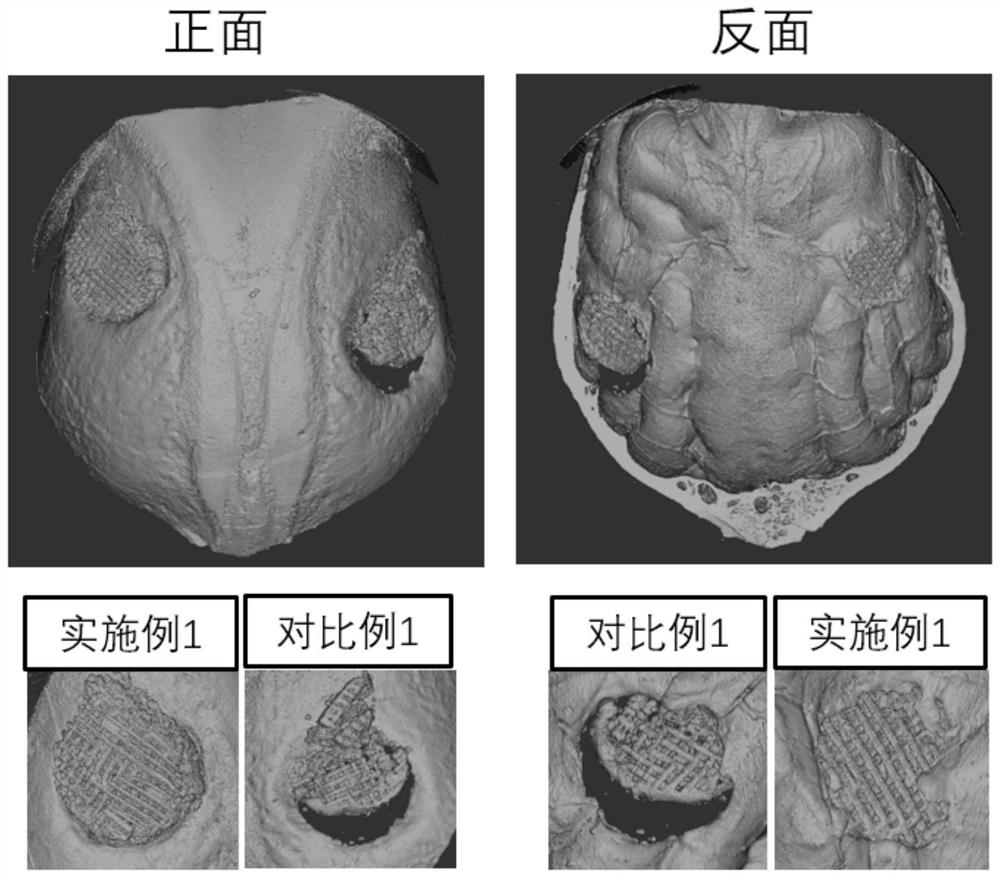A 3D printed bone tissue engineering scaffold with slow-release and osteogenesis-promoting functions, its preparation method and application
A tissue engineering scaffold and 3D printing technology, applied in the field of biomedical materials, can solve the problems of slow healing of bone tissue and poor osteogenic performance, and achieve good biocompatibility, good bone repair effect, and good biological activity.
- Summary
- Abstract
- Description
- Claims
- Application Information
AI Technical Summary
Problems solved by technology
Method used
Image
Examples
Embodiment 1
[0047] (1) Preparation of 3D printing ink
[0048] In a water bath at 30°C, add sodium alginate powder material to deionized water to prepare a 6% sodium alginate solution, add 1ml of icariin-dimethyl sulfoxide solution with a concentration of 0.1g / ml, and use a magnetic Mix it well with a mixer until smooth. After preheating at 50°C for 30-60 minutes, reduce the viscosity of the sodium alginate solution, then slowly add the solid calcium phosphate powder into the preheated solution, and mix the slurry evenly with a homogeneous mixer until no phosphoric acid is observed Calcium agglomerates. The mass ratio of calcium phosphate, sodium alginate, icariin and deionized water in the final slurry is 25:6:0.08:100. This mixed slurry is used as 3D printing ink.
[0049] (2) printing support
[0050] The three-dimensional model of the scaffold was designed by 3D modeling software, and the mixed ink was printed into a calcium phosphate scaffold with a first-level macroporous structur...
Embodiment 2
[0062] The 3D printed bone tissue engineering scaffold material was prepared with reference to the method described in Example 1, which differs from Example 1 in that the mass ratio of calcium phosphate, sodium alginate, icariin and deionized water was adjusted to 25:6 : 0.04: 100, all the other processing methods are the same as those described in Example 1. The experimental results show that the obtained scaffold has a slow-release function and an osteogenesis-promoting effect, but compared with Example 1, due to the lower solid content of icariin in the printing paste, bone tissue with slow-release and osteogenesis-promoting functions The total drug loading of the engineering scaffold is less, and the osteogenesis-promoting function of the scaffold obtained in this embodiment on bone defects is better than that of Comparative Example 1, but slightly worse than that of Example 1.
Embodiment 3
[0064] The 3D printed bone tissue engineering scaffold material was prepared with reference to the method described in Example 1, which differs from Example 1 in that the mass ratio of calcium phosphate, sodium alginate, icariin and deionized water was adjusted to 25:6 : 0.16: 100, all the other processing methods are the same as those described in Example 1. The experimental results show that the obtained scaffold has slow-release function and osteogenesis-promoting effect. Since the solid content of icariin in the printing slurry is more than that of Examples 1 and 2, the bone tissue engineering scaffold with slow-release and osteogenesis-promoting function The total amount of drug loaded is more, and the bone defect-promoting function of the scaffold obtained in this embodiment is better than that of Examples 1 and 2.
PUM
| Property | Measurement | Unit |
|---|---|---|
| concentration | aaaaa | aaaaa |
| concentration | aaaaa | aaaaa |
Abstract
Description
Claims
Application Information
 Login to View More
Login to View More - R&D
- Intellectual Property
- Life Sciences
- Materials
- Tech Scout
- Unparalleled Data Quality
- Higher Quality Content
- 60% Fewer Hallucinations
Browse by: Latest US Patents, China's latest patents, Technical Efficacy Thesaurus, Application Domain, Technology Topic, Popular Technical Reports.
© 2025 PatSnap. All rights reserved.Legal|Privacy policy|Modern Slavery Act Transparency Statement|Sitemap|About US| Contact US: help@patsnap.com


